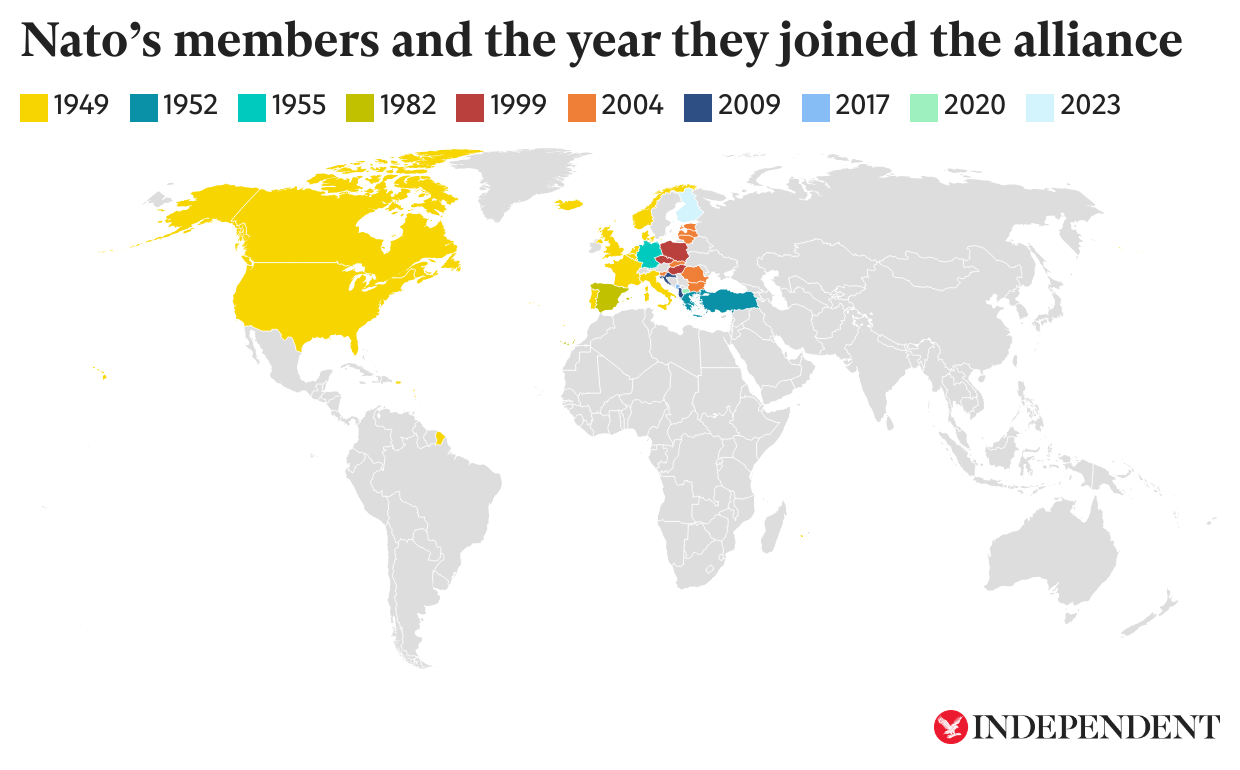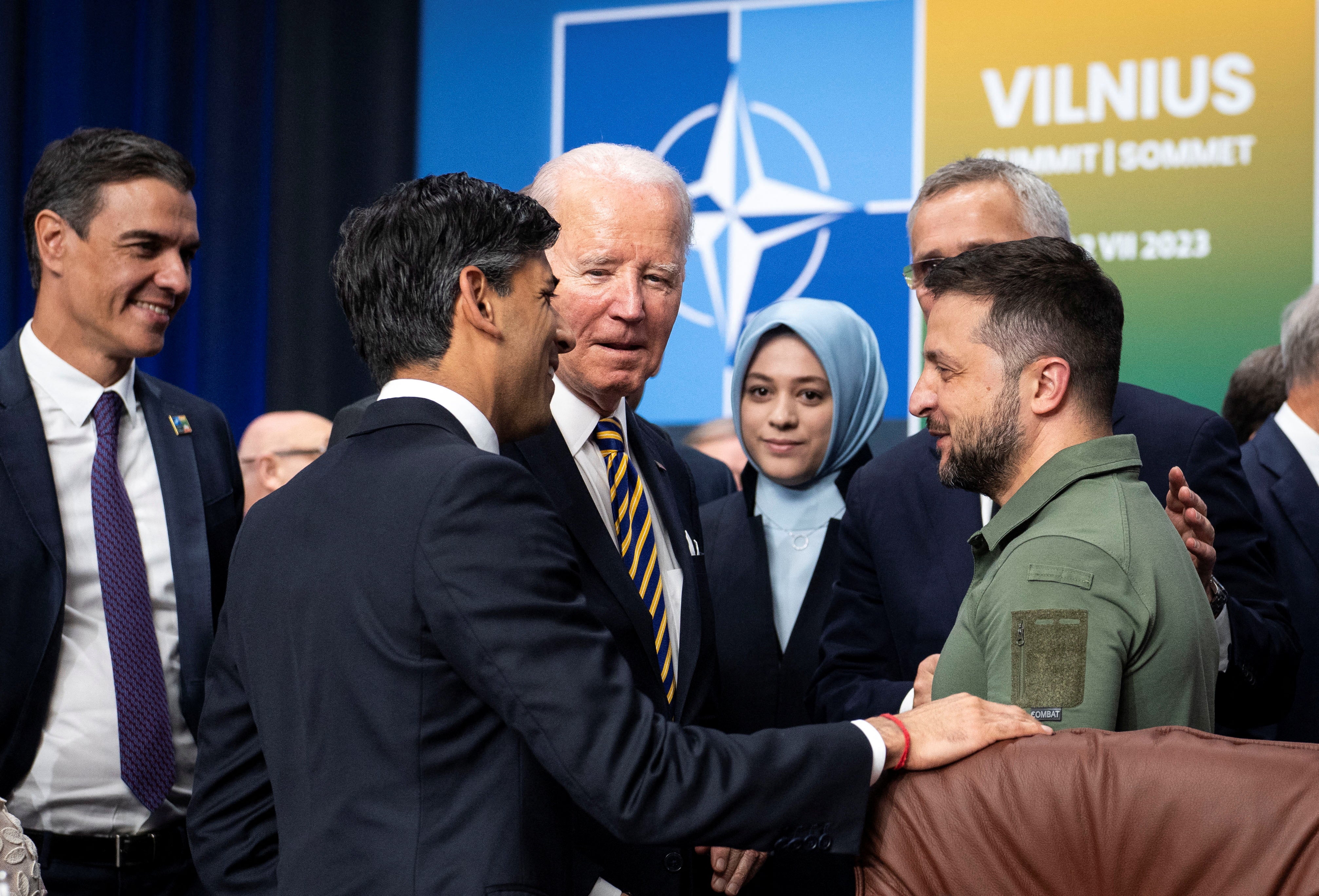Nato in numbers: Which members have the biggest armies and how has the military alliance grown?
Security organisation founded in 1949 now has 31 members who are set to spend $1.26trn on defence this year. The alliance has a collective military might of 3.5m army personnel to call upon
The North Atlantic Treaty Organisation (Nato), which is currently holding its latest summit in Vilnius, Lithuania, is a political and military alliance of North American and European countries forged in the aftermath of the Second World War – in the hope of avoiding future hostilities between nations.
It sought to achieve this through the realisation of three specific goals: deterring Soviet expansionism, preventing the revival of militant nationalism and encouraging European political integration.
While that first obligation lost its relevance following the fall of the Berlin Wall in 1989 and the gradual disintegration of the USSR, Nato has been forced to constantly evolve and adapt in response to global geopolitical tensions over the last half century as the nature of the threats and challenges nations faced changed, from fascism and totalitarianism to Islamist terror factions and cyber-warfare.
The organisation’s member states are obliged by Article 5 of the alliance’s treaty to come to the aid of any fellow signatory in the event that they should come under attack from a foreign power.
In its own words: “Nato is committed to the peaceful resolution of disputes. If diplomatic efforts fail, it has the military power to undertake crisis-management operations.”

The organisation has its headquarters in Brussels, Belgium, its current secretary general is Jens Stoltenberg and its most recent entrant was Finland earlier this year, with Sweden now looking likely to follow suit, abandoning two centuries of political neutrality in the face of the threat posed to national security in Europe by Russia since the advent of its invasion of Ukraine on 24 February 2022.
Here’s a look at the key numbers that define Nato:
12
The number of founding member nations from Europe and North America who signed the North Atlantic Treaty on 4 April 1949, pledging to contain any future military threat from a revived Germany or the Soviet Union at a time when the Marshall Plan was attempting to bring economic deliverance to a stricken continent still in recovery from a war that had killed 36.5m people where rationing was still a fact of everyday life.
Those countries were: Belgium, Canada, Denmark, France, Iceland, Italy, Luxembourg, the Netherlands, Norway, Portugal, the United Kingdom and the United States.
31
The current total number of member states.
The original dozen were supplemented by Greece and Turkey in 1952 and West Germany in 1955 and, later, post-Franco Spain in 1982.
Having held steady throughout the Cold War and such testing diplomatic episodes as the Cuban Missile Crisis, the Vietnam War and the Soviet invasion of Afghanistan, Nato’s membership held at 16 until 1999, when three former Russian satellite states – Czechia, Hungary and Poland – were inducted, followed by a second tranche in 2004 made up of Bulgaria, Estonia, Latvia, Lithuania, Romania, Slovakia and Slovenia, much to the displeasure of the new man in the Kremlin, Vladimir Putin.
In 2009, Albania and Croatia joined up, followed by Montenegro (2017) and North Macedonia (2020) and finally Finland this year.
Article 10 of the North Atlantic Treaty states that membership of Nato is open to any “European State in a position to further the principles of this Treaty and to contribute to the security of the North Atlantic area”.
2%
The minimum percentage of a member state’s gross domestic product they are expected to spend on defence as part of their commitment to the alliance.
This does not always prove possible, however, with countries often facing economic challenges of their own. This famously led then-US president Donald Trump to lambast the membership for their failure to meet their commitments at a summit in Brussels in July 2018 – and suggest that they should not only pay their dues but that the rate should be doubled to 4 per cent.

Rishi Sunak repeated the call for members to increase their spending in Vilnius this year, saying the current target “must be a floor not a ceiling”.
$1.26 trillion
The total amount Nato defence spending is forecast to reach in 2023 (equating to £975bn), according to its own estimates, up from $943.2bn (£730bn) in 2014, the year Russia last launched expansionist aggressions by annexing Crimea.
The top spending member state this year will, as usual, be the US on $860bn (£666bn), followed some way behind by Germany on $68.1bn (£52.7bn), the UK on $65.8bn (£51bn), France on $56.6bn (£43.8bn) and Italy on $31.6bn (£24.5bn), all of which are significantly up on a decade ago to reflect the heightened threat posed by Russia’s war in Ukraine.
1.35 million
The size of the single biggest army within Nato in terms of personnel, according to research by Statista, which belongs to the US.
Perhaps more surprisingly, the Nato member with the second-largest military is Turkey, with 447,000 personnel.
France is next on the list with 207,100, Germany has 188,500, Italy 174,800 and the UK 156,200.
3.5 million
The total number of military personnel, troops and civilians Nato can count on from its member states, by its own estimation.
Each member agrees to contribute what it can to the alliance, each bringing different strategic weight and regional influence in the interest of bolstering the security of continental Europe.



Join our commenting forum
Join thought-provoking conversations, follow other Independent readers and see their replies
Comments